 Technology peripherals
Technology peripherals
 AI
AI
 80% of white-collar workers are in danger! OpenAI releases employment tips in the GPT era: 34 iron rice bowls to save your life
80% of white-collar workers are in danger! OpenAI releases employment tips in the GPT era: 34 iron rice bowls to save your life
80% of white-collar workers are in danger! OpenAI releases employment tips in the GPT era: 34 iron rice bowls to save your life
A few days after the release of GPT-4, OpenAI directly told everyone that GPTs are general-purpose technology and 80% of American jobs will be affected. If you want to save your life, take a look at these 34 "iron rice bowls."
As soon as GPT-4 was launched, OpenAI released a 35-page paper official announcement:
80% of Americans will be affected by AI.
Researchers say that GPT will be a "universal technology" like a steam engine or a printing press.
In this way, the OpenAI industrial revolution is real!
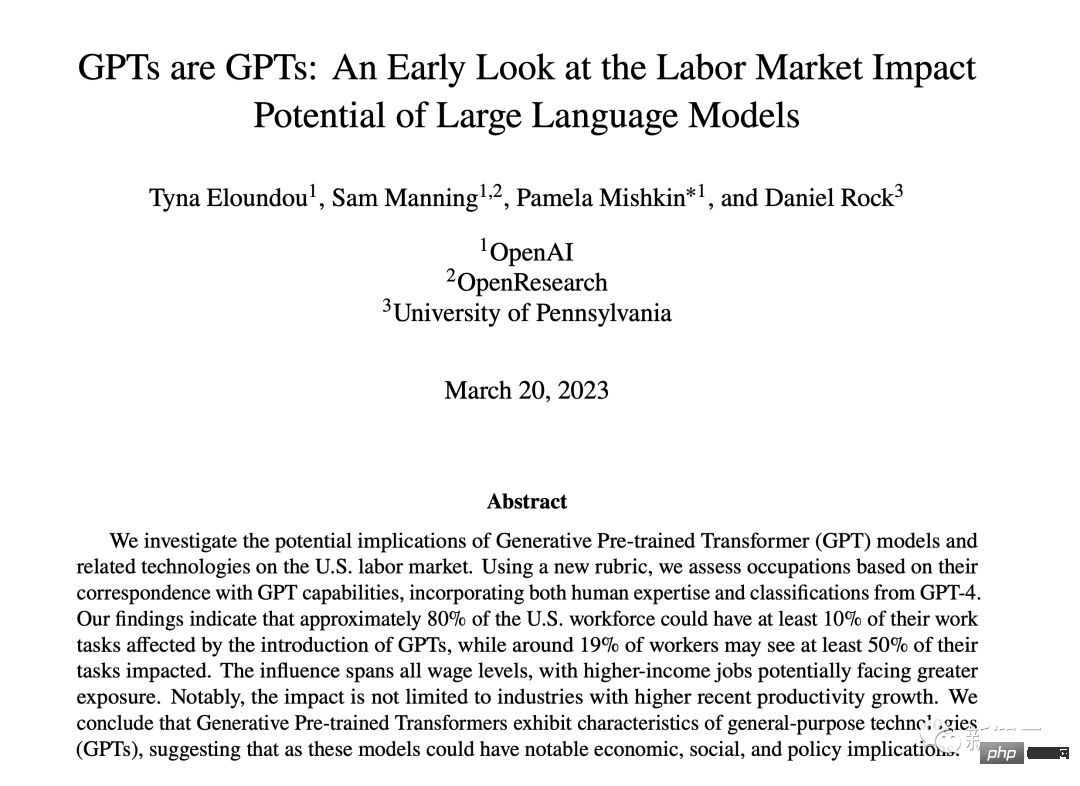
Paper address: https://arxiv.org/abs/2303.10130
The paper states that for about 80% of Americans, at least 10% of work tasks will be affected by GPT.
At the same time, in about 19% of jobs, 50% of tasks will be automated by AI to some extent.
Moreover, this impact spans almost all industries. The higher the academic qualifications, the higher the income, and the better AI is at the work done by "white-collar workers", which means that the possibility of being replaced by AI is greater.
So are there jobs that AI cannot replace? have!
OpenAI also listed 34 "iron rice bowls" that will not be affected by AI, telling blue-collar people that you are "safe."
Including dishwashers, bartenders, plumbers, and landscaping workers.
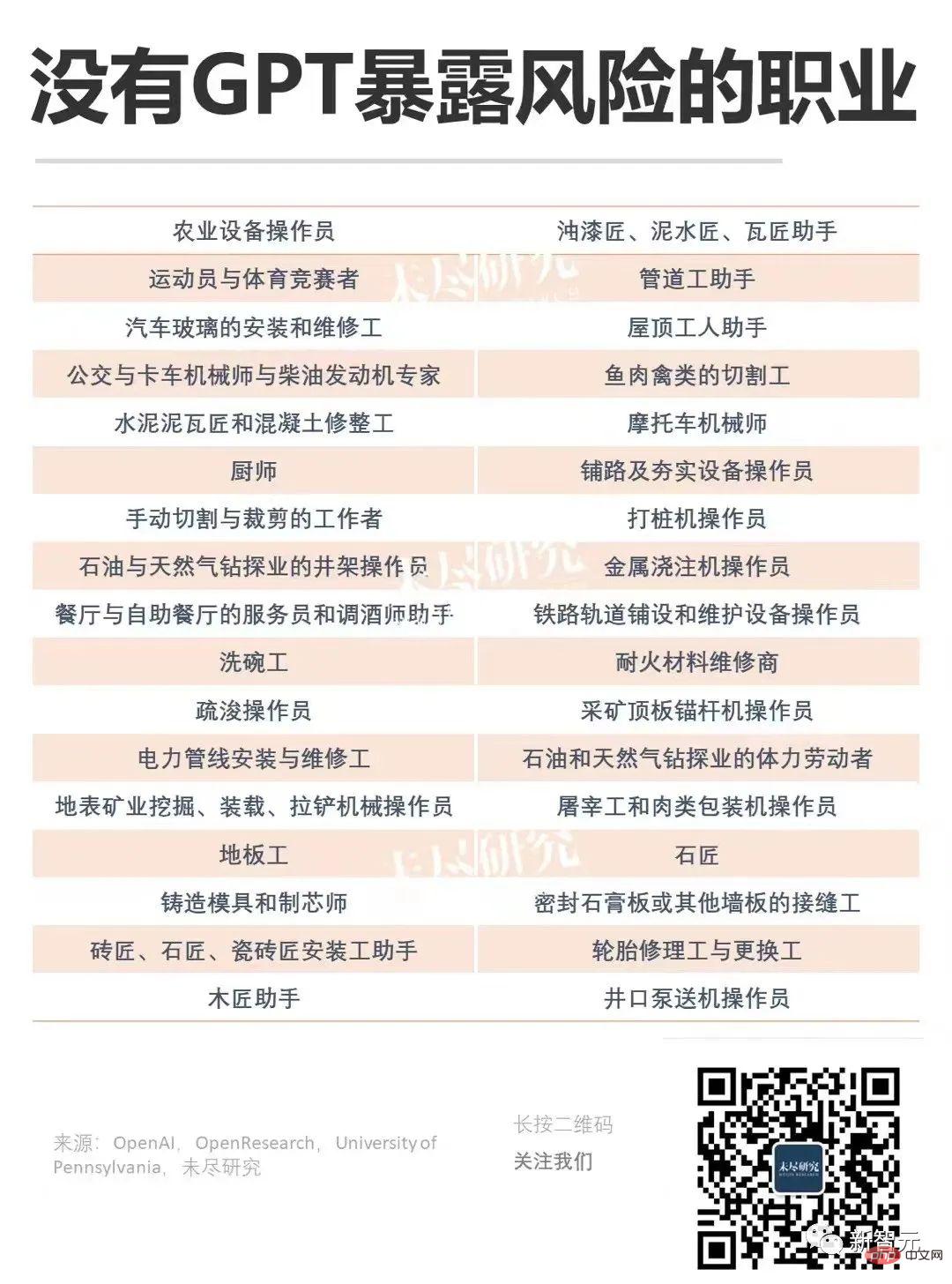
Source: Unexhausted Research
After counting the 34 iron rice bowls in detail, it seems that even the system at the end of the universe is not working well.
The more you earn, the more dangerous it becomes?
GPT will affect most human work. Who gives OpenAI the confidence to dare to draw this conclusion?
The paper first presents the performance transition diagram from GPT-3.5 to GPT-4, allowing everyone to see the development speed of large models (the GPT-4 technical report is moved here):
GPT-4 performs at par with human levels on a variety of professional tests and academic benchmarks. achieved almost perfect scores in major exams, including the GRE, sweeping various benchmarks.
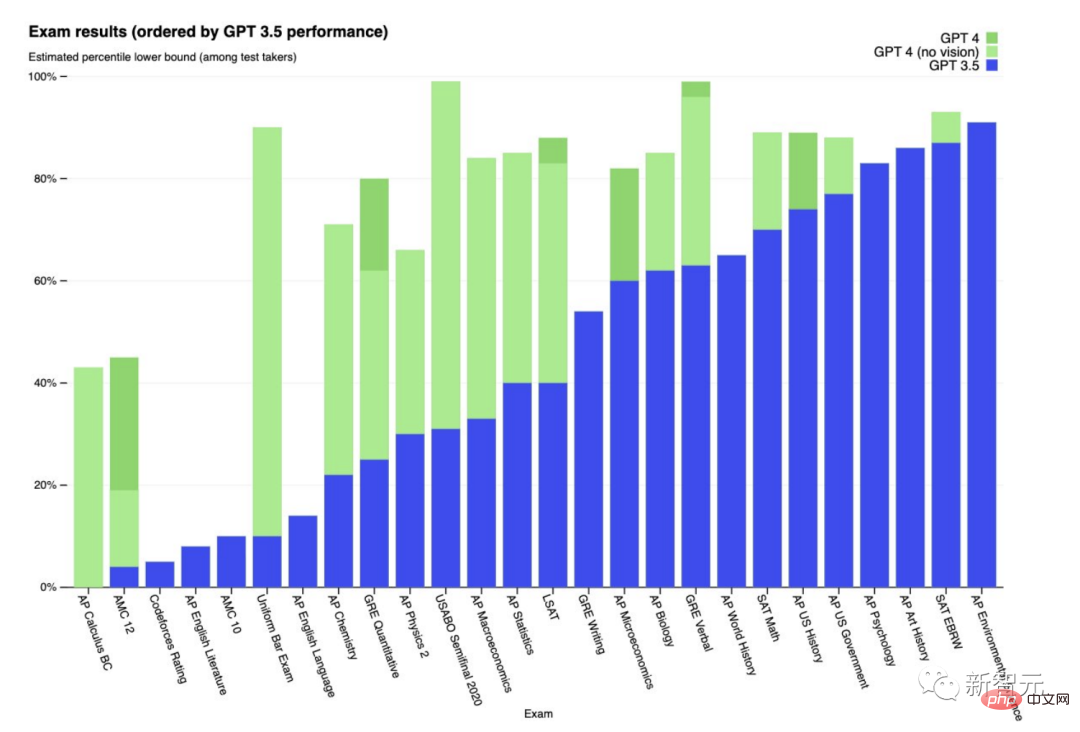
#Looking at it this way, it’s not unreasonable to replace you. So, OpenAI came up with a definition.
In the latest paper, OpenAI directly calls GPTs general-purpose technologies (GPTs). In short, GPTs are general-purpose technologies.
Universal technology refers to technology that meets three core criteria - technology that continues to improve over time, is ubiquitous in the economy, and can generate relevant innovations.
There is no doubt that GPT continues to improve over time and therefore meets the first criterion.
The researchers said in the paper that two other standards are also gradually being implemented. Early qualitative evidence suggests that LLM adoption and use is growing in popularity.
Next, let’s take a look at the conclusions of the paper.
Occupations most susceptible to LLM are: tax preparers, interpreters and translators, research researchers, proofreaders and transcribers, and writers.
Among them, jobs with 100% exposure include mathematicians, tax preparers, quantitative financial analysts, writers, and web and digital interface designers.
There are even blockchain engineers.
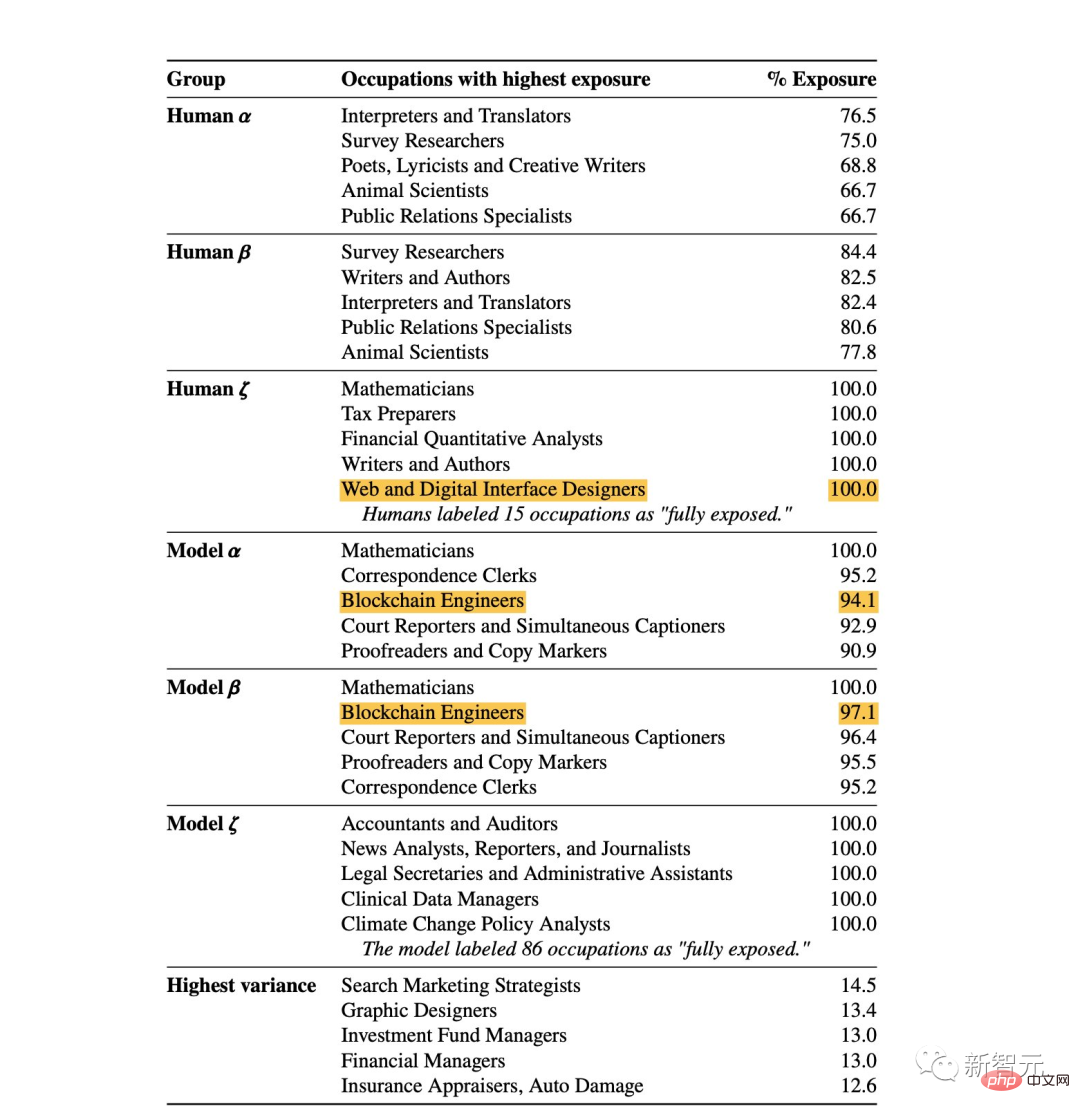
At the beginning, we listed occupations that are not affected by LLM at all: mainly manual workers.
This is very consistent with Moravec’s Paradox, which is that robotics that can reliably automate most manual labor is still many years away.
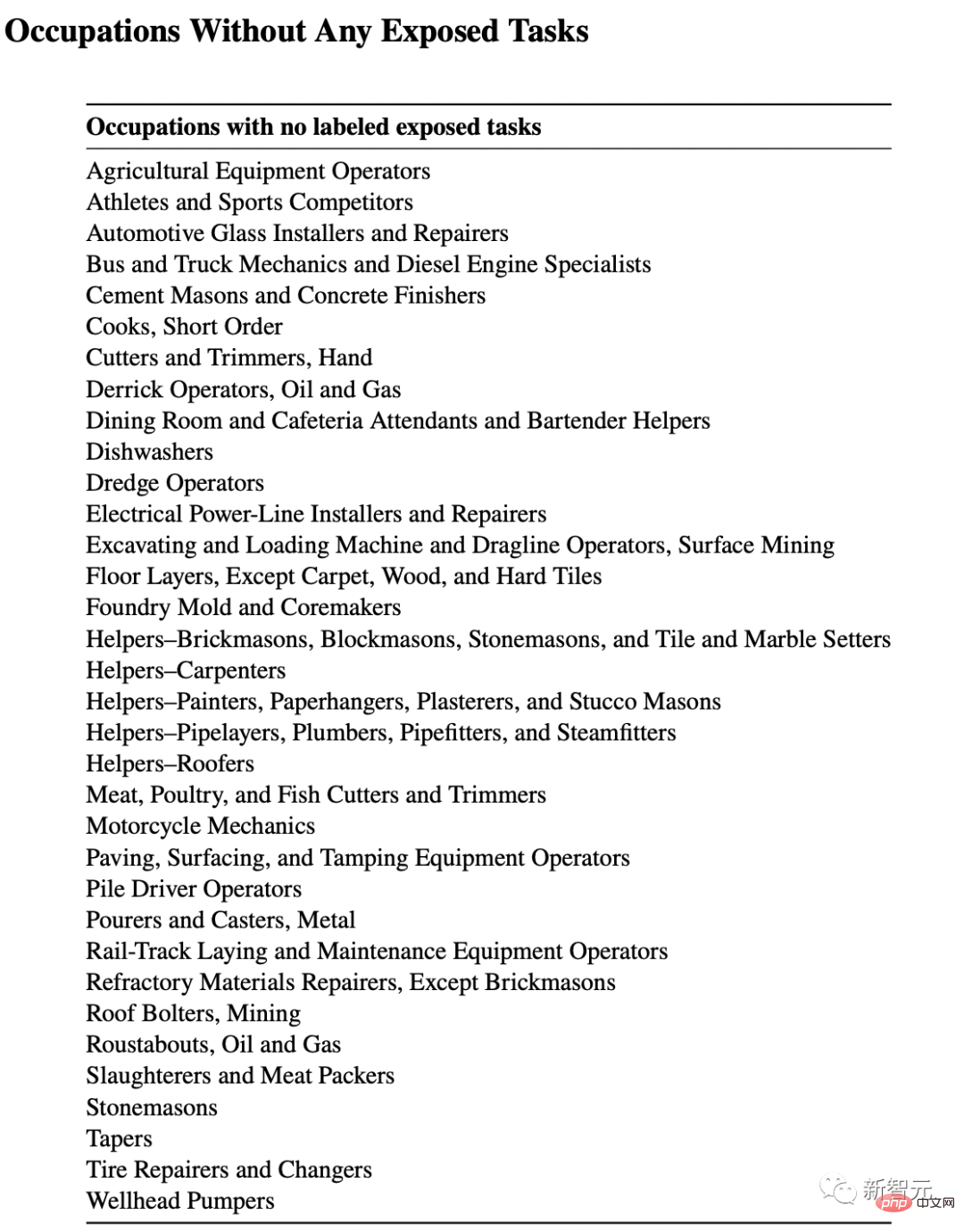
So how to define this "exposure rate"?
The exposure percentage indicates whether accessing GPT, or a GPT-driven system, would reduce the time it takes humans to perform a task by at least 50%, the paper states.

Of course, OpenAI also stated that the above tasks may not necessarily be fully automated by GPT.
Plotting human scores (x-axis) and GPT-4 scores (y-axis) as functions shows high consistency in GPT exposure by occupation.
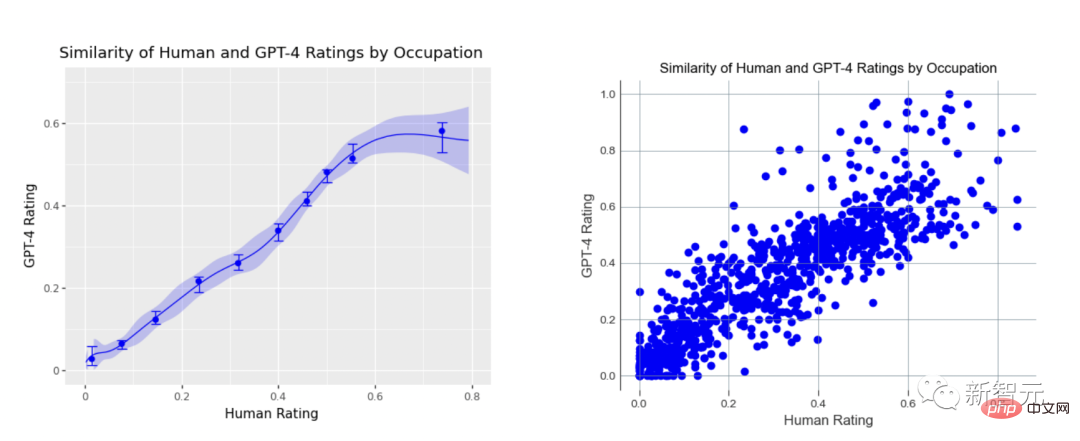
#The paper also points out that the higher the salary, the higher the chance of being automated by LLM. The good news, though, is that jobs that require scientific and critical thinking skills have lower exposure rates.

The specific linear relationship is as shown below. The double scatter plot below depicts the exposure to LLMs for various occupations assessed by human evaluators and GPT-4.
These figures compare GPT-exposed occupations with the logarithm of occupation employment and the logarithm of occupation median annual salary.
While there are some differences, human and GPT-4 evaluations indicate that occupations with higher wages tend to be affected by LLMs.

By work area, those with a bachelor's degree or higher are more likely to be exposed to GPT than those without a bachelor's degree.

#How do the numbers in the above table come from? The author of the paper defined 4 levels of "exposure scoring standards."
E0: Not exposed. For example, tasks that require a high degree of human interaction, precise measurements, detailed review of visuals, physical labor, etc.
E1: Directly exposed, using LLM can reduce the time to complete the task by at least half.
E2: Reduce the workload by at least half with LLM-driven applications.
E3: In view of the exposure of image capabilities, it is similar to E2, but requires multi-modal GPT-4 and vision API.

Netizen: After reading the paper, I knew I still had to wash the dishes!
NVIDIA scientist Jim Fan issued an article calling on everyone to face up to this "elephant in the room" - will LLM take over our work?
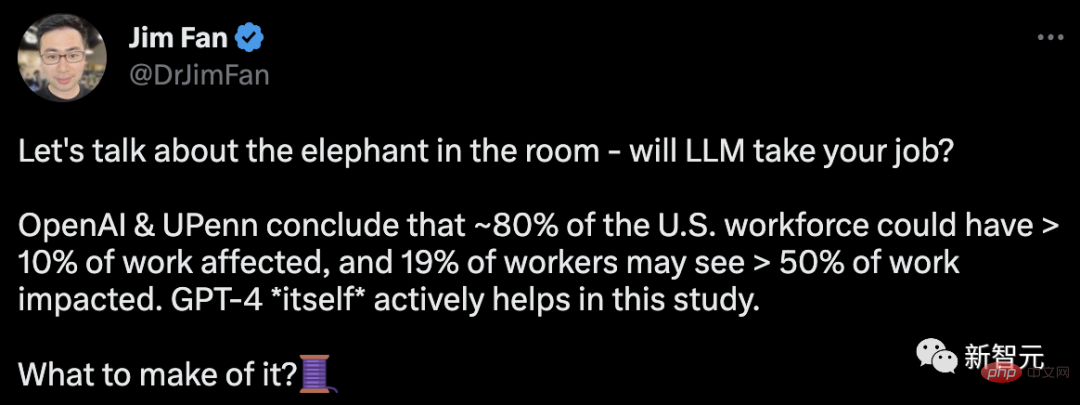
Some netizens also issued soul torture:
"In the past 10 years, I believe that artificial intelligence can eliminate the need for human beings to have things in their minds." liberated from the task and move the world towards a more creative future. However, with the emergence of models such as Stable Diffusio, artists have also been eliminated. If human logic and creativity could be replaced, do you think that would remain What kind of job?"
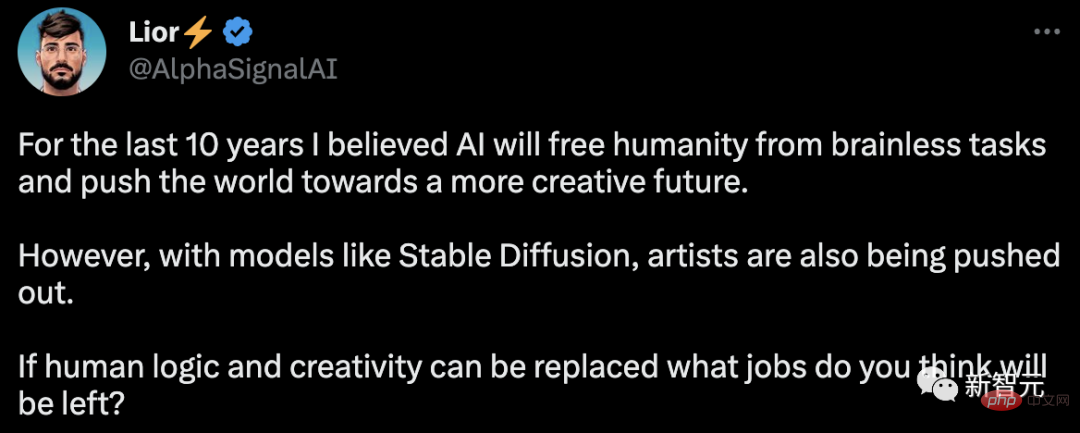
#The limitations of language are the limitations of my world.

Some netizens concluded that this article revealed the tip of the terrible iceberg: most of the threats and impacts brought to us by LLM are still below the sea level, and they are not at all It has never appeared.

John Carmack recently tweeted that he had received a private message and hoped that his answer could be seen by everyone.

The students who wrote private messages mainly elaborated on their concerns: (This may be the problem deep in the hearts of many children today)
I am interested in computer science ( Software engineering in particular) are very passionate and would like to pursue a career in this field. But I have to worry about the development of artificial intelligence (such as GPT-4), will programming jobs still exist in the future? I know it's hard to predict what the next 10-15 years will look like, but my main concern is that I may have worked so hard for nothing and Al will eventually eliminate me from my future job. Do you have any ideas?
Carmack replied that you need to build complete "product skills" for the job and use the best tools. Today you may be writing code by hand, but in the future you may be assisted by Al, and you will get better and better.
Software is just a tool to help people get something done, and many programmers never understand this. Focus on the value delivered and don’t get too hung up on the specifics of the tool.
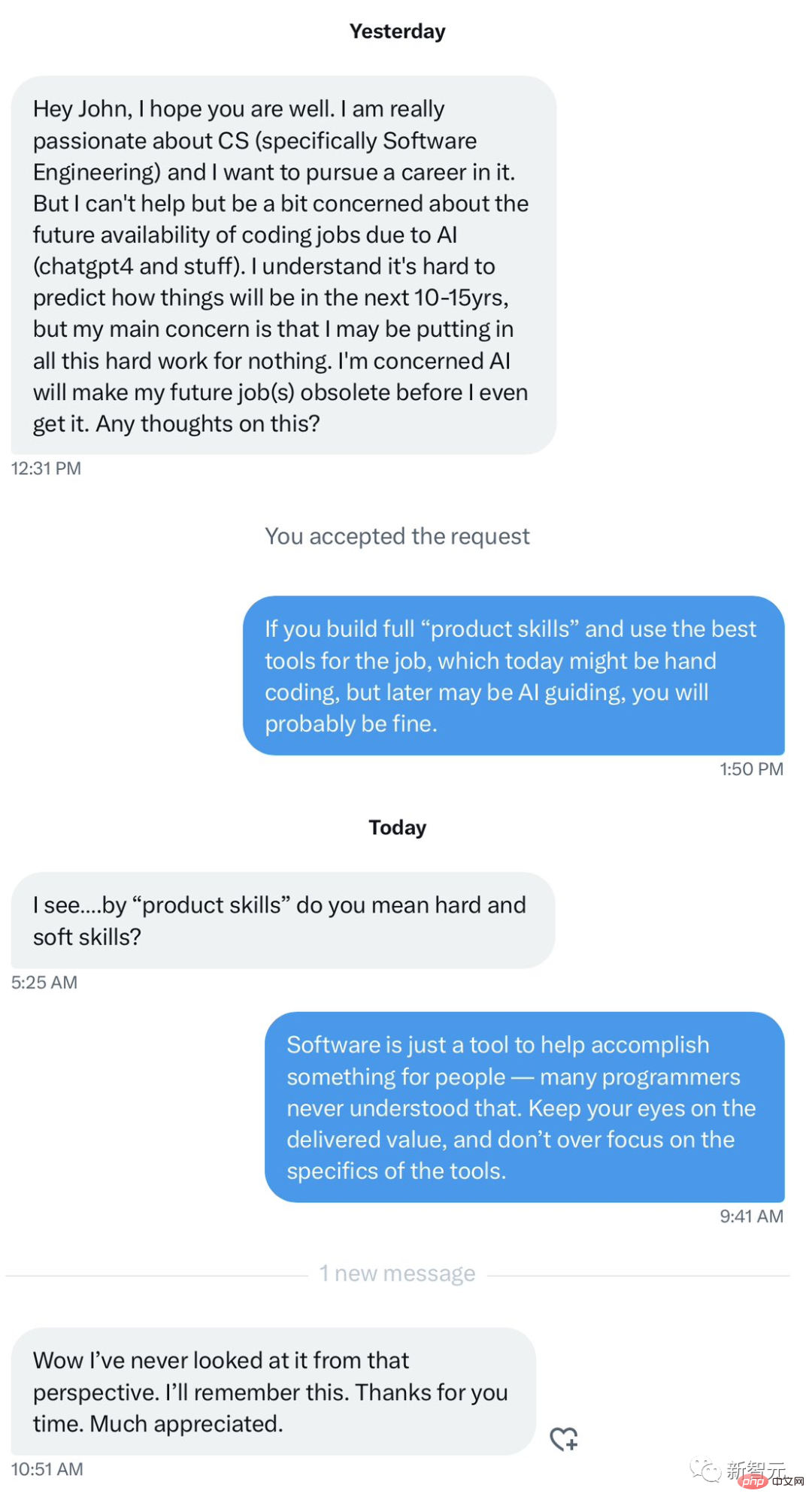
Foreign media said that the OpenAI paper may be somewhat alarmist.
Because OpenAI is bragging about its GPT, it has to portray it as a tool that disrupts industries and automates tasks so that employers can start using it to reduce costs.
Some netizens even said that this paper is basically meaningless because it does not put forward a time limit for its predictions.

In a recent interview with ABC NEWS, Sam Altman once said, "ChatGPT should be viewed as a tool, not a replacement for any job."
He explained that humans have proven this time and time again by constantly adapting to different types of technology. Human creativity is unlimited, we can create new jobs and find new things to do.

However, the most ironic thing is that OpenAI is now selling GPT as a general-purpose technology.
In October 2017, the cover article of "The New Yorker" "Humanity will only be able to help robots in the future" painted such a picture of the future:
A young beggar with a beard sitting in the future Begging on the streets of Manhattan, the robot next to him threw screws and nuts into the cup in his hand. The puppy next to him was also full of surprise and looked at the robot dog walking by with worry.
Perhaps, OpenAI wants to tell us that this future is not far away.
The above is the detailed content of 80% of white-collar workers are in danger! OpenAI releases employment tips in the GPT era: 34 iron rice bowls to save your life. For more information, please follow other related articles on the PHP Chinese website!

Hot AI Tools

Undresser.AI Undress
AI-powered app for creating realistic nude photos

AI Clothes Remover
Online AI tool for removing clothes from photos.

Undress AI Tool
Undress images for free

Clothoff.io
AI clothes remover

Video Face Swap
Swap faces in any video effortlessly with our completely free AI face swap tool!

Hot Article

Hot Tools

Notepad++7.3.1
Easy-to-use and free code editor

SublimeText3 Chinese version
Chinese version, very easy to use

Zend Studio 13.0.1
Powerful PHP integrated development environment

Dreamweaver CS6
Visual web development tools

SublimeText3 Mac version
God-level code editing software (SublimeText3)

Hot Topics
 Which of the top ten currency trading platforms in the world are the latest version of the top ten currency trading platforms
Apr 28, 2025 pm 08:09 PM
Which of the top ten currency trading platforms in the world are the latest version of the top ten currency trading platforms
Apr 28, 2025 pm 08:09 PM
The top ten cryptocurrency trading platforms in the world include Binance, OKX, Gate.io, Coinbase, Kraken, Huobi Global, Bitfinex, Bittrex, KuCoin and Poloniex, all of which provide a variety of trading methods and powerful security measures.
 Recommended reliable digital currency trading platforms. Top 10 digital currency exchanges in the world. 2025
Apr 28, 2025 pm 04:30 PM
Recommended reliable digital currency trading platforms. Top 10 digital currency exchanges in the world. 2025
Apr 28, 2025 pm 04:30 PM
Recommended reliable digital currency trading platforms: 1. OKX, 2. Binance, 3. Coinbase, 4. Kraken, 5. Huobi, 6. KuCoin, 7. Bitfinex, 8. Gemini, 9. Bitstamp, 10. Poloniex, these platforms are known for their security, user experience and diverse functions, suitable for users at different levels of digital currency transactions
 Decryption Gate.io Strategy Upgrade: How to Redefine Crypto Asset Management in MeMebox 2.0?
Apr 28, 2025 pm 03:33 PM
Decryption Gate.io Strategy Upgrade: How to Redefine Crypto Asset Management in MeMebox 2.0?
Apr 28, 2025 pm 03:33 PM
MeMebox 2.0 redefines crypto asset management through innovative architecture and performance breakthroughs. 1) It solves three major pain points: asset silos, income decay and paradox of security and convenience. 2) Through intelligent asset hubs, dynamic risk management and return enhancement engines, cross-chain transfer speed, average yield rate and security incident response speed are improved. 3) Provide users with asset visualization, policy automation and governance integration, realizing user value reconstruction. 4) Through ecological collaboration and compliance innovation, the overall effectiveness of the platform has been enhanced. 5) In the future, smart contract insurance pools, forecast market integration and AI-driven asset allocation will be launched to continue to lead the development of the industry.
 What are the top currency trading platforms? The top 10 latest virtual currency exchanges
Apr 28, 2025 pm 08:06 PM
What are the top currency trading platforms? The top 10 latest virtual currency exchanges
Apr 28, 2025 pm 08:06 PM
Currently ranked among the top ten virtual currency exchanges: 1. Binance, 2. OKX, 3. Gate.io, 4. Coin library, 5. Siren, 6. Huobi Global Station, 7. Bybit, 8. Kucoin, 9. Bitcoin, 10. bit stamp.
 What are the top ten virtual currency trading apps? The latest digital currency exchange rankings
Apr 28, 2025 pm 08:03 PM
What are the top ten virtual currency trading apps? The latest digital currency exchange rankings
Apr 28, 2025 pm 08:03 PM
The top ten digital currency exchanges such as Binance, OKX, gate.io have improved their systems, efficient diversified transactions and strict security measures.
 How to use the chrono library in C?
Apr 28, 2025 pm 10:18 PM
How to use the chrono library in C?
Apr 28, 2025 pm 10:18 PM
Using the chrono library in C can allow you to control time and time intervals more accurately. Let's explore the charm of this library. C's chrono library is part of the standard library, which provides a modern way to deal with time and time intervals. For programmers who have suffered from time.h and ctime, chrono is undoubtedly a boon. It not only improves the readability and maintainability of the code, but also provides higher accuracy and flexibility. Let's start with the basics. The chrono library mainly includes the following key components: std::chrono::system_clock: represents the system clock, used to obtain the current time. std::chron
 How to measure thread performance in C?
Apr 28, 2025 pm 10:21 PM
How to measure thread performance in C?
Apr 28, 2025 pm 10:21 PM
Measuring thread performance in C can use the timing tools, performance analysis tools, and custom timers in the standard library. 1. Use the library to measure execution time. 2. Use gprof for performance analysis. The steps include adding the -pg option during compilation, running the program to generate a gmon.out file, and generating a performance report. 3. Use Valgrind's Callgrind module to perform more detailed analysis. The steps include running the program to generate the callgrind.out file and viewing the results using kcachegrind. 4. Custom timers can flexibly measure the execution time of a specific code segment. These methods help to fully understand thread performance and optimize code.
 How much is Bitcoin worth
Apr 28, 2025 pm 07:42 PM
How much is Bitcoin worth
Apr 28, 2025 pm 07:42 PM
Bitcoin’s price ranges from $20,000 to $30,000. 1. Bitcoin’s price has fluctuated dramatically since 2009, reaching nearly $20,000 in 2017 and nearly $60,000 in 2021. 2. Prices are affected by factors such as market demand, supply, and macroeconomic environment. 3. Get real-time prices through exchanges, mobile apps and websites. 4. Bitcoin price is highly volatile, driven by market sentiment and external factors. 5. It has a certain relationship with traditional financial markets and is affected by global stock markets, the strength of the US dollar, etc. 6. The long-term trend is bullish, but risks need to be assessed with caution.





